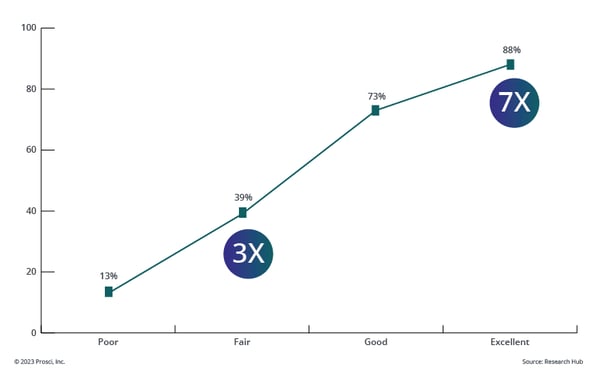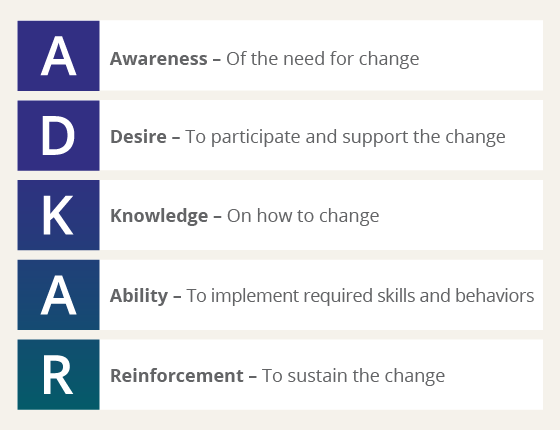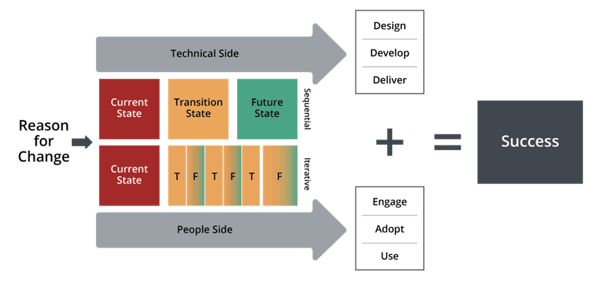Understanding Organizational Change Management Strategies

7 Mins
Updated: November 18, 2025
Published: September 2, 2024

At Prosci, organizational change management goes beyond systems and technology—it’s about people. While "change management" may be defined differently across industries, our focus is always on the people side of change.
For individuals, this means guiding them through personal transitions with structured frameworks, helping them adapt to change with clarity and confidence. At the organizational level, these efforts are scaled to ensure teams and departments can adopt and sustain new working methods.
Whether you’re managing a new system, improving processes, or driving large-scale initiatives, success depends on preparing, equipping, and supporting people. Understanding individual and organizational change is essential to achieving your project’s goals and ensuring lasting success.
What is (OCM) Organizational Change Management?
OCM, otherwise known as Organizational change management is a structured approach for preparing, equipping, and enabling people to adopt and use change effectively in their daily work. By prioritizing the people side of change, organizations can turn potential disruptions into opportunities for growth.
For example, consider a new software implementation: organizational change management involves clear communication about the benefits, hands-on training sessions for employees, and ongoing support to address challenges as they arise. Or consider a shift in company culture: change management might include leadership modeling desired behaviors, workshops to build new mindsets, and recognition programs that celebrate early adopters.
When applied early in the change process, a structured change management methodology builds stronger teams, fosters collaboration, and creates a culture that thrives on continuous improvement. With the right strategies, challenges become catalysts for innovation, and obstacles transform into pathways for long-term success. An effective change management strategy supports individuals through change and lays the foundation for sustainable growth, positioning the organization to achieve its desired outcomes and maintain momentum into the future.
The People Side of Organizational Change
The heart of any successful transformation is the people who bring those changes to life. At its core, the people side of organizational change is about understanding and addressing the emotions, motivations, and concerns that individuals experience when faced with change.
However, identifying emotions and motivations is just the first step. Organizations can drive people-centered change by combining this understanding with an individual change management model, like the Prosci ADKAR® Model. ADKAR focuses on building Awareness, Desire, Knowledge, Ability and Reinforcement at the individual level, ensuring that each person is prepared and supported through the transition.
The Prosci Methodology offers an organization-wide, people-centered change management framework to amplify and scale change across teams and entire cultures. This is achieved through the Prosci 3-Phase Process and the Prosci Change Triangle (PCT) Model, which enable leaders to align individual efforts with broader organizational goals.
Understanding the human side of change means appreciating that each person’s journey is unique. Some may eagerly embrace new possibilities, while others may feel uncertain or overwhelmed. The Prosci Methodology supports the technical aspects of a project and centers on the human experience, ensuring individuals and organizations are set up for lasting success.
When we focus on people, we set the stage for lasting success. But the impact of effective change management extends beyond individual engagement.

The Value of Organizational Change Management
Organizational change management aligns closely with both short-term goals and long-term strategic objectives. It helps organizations not only meet immediate project targets but also fosters a culture of adaptability and resilience. By integrating change management into your strategic planning, you ensure that each change initiative contributes to the broader vision and objectives of the company, enhancing overall business performance.
But why should you care about the people side of change? Because if you’re a business leader, project manager, or member of a project team, you want your organizational initiatives to succeed. Missed milestones, poor adoption, rework and negative perceptions put your project at risk.
Prosci research shows a direct correlation between applying excellent organizational change management to projects and being:
- 65% more likely to stay on schedule
- 71% more likely to stay on budget
- 88% more likely to meet objectives
This all adds up to achieving your target return on investment (ROI) for your change initiatives. Our data also shows that companies with excellent organizational change management are seven times more likely to achieve their desired outcomes.
Correlation of Change Management Effectiveness with Meeting Objectives

Effective organizational change management involves implementing processes and frameworks to overcome knowledge gaps and barriers to change at the individual, team and company levels. The Prosci Change Triangle (PCT) Model is a key example of a structured change management model that drives change across all levels. It focuses on four critical aspects of successful change—Success, Leadership/Sponsorship, Project Management and Change Management—and how they relate to promoting project health.
The PCT Model ensures a holistic approach and framework for success by bringing clarity and alignment to a project or initiative. It also enables you to measure progress and proactively identify areas for improvement over time. And with Success at the model's center, it emphasizes the importance of defining clear objectives and organizational benefits, especially for your senior leaders who must provide the necessary resources and direction.
Successful change management practices also create a ripple effect within an organization, promoting continuous learning and innovation. When change is managed effectively, it leads to stronger team cohesion, higher employee engagement, and a more agile organization capable of responding to market shifts and evolving business needs. This alignment with business outcomes transforms change management from a one-time effort into a sustainable practice that drives long-term growth and success.
3 Levels of Change Management
Now that you understand what organizational change management is and some of the value it brings to projects and initiatives, let’s break it down into its basic applications. Change management happens on three levels: the individual level, project or initiative level, and enterprise level. Although they are interrelated, each level has a distinct focus.
1. Change management for individuals
All change happens at the individual level. To manage change effectively, we need to understand how people experience change and what support they require to transition successfully. What messages do people need to hear? When should messages be sent, and who should they come from? When is the optimal time to teach someone a new skill? How do you coach people to adopt new behaviors? And what will make the changes “stick”?
One of the biggest challenges individuals face during large-scale change initiatives is resistance to change. Prosci’s research highlights that the most common reason for resistance is not fear of change itself but rather a lack of awareness about why the change is necessary.
It’s crucial to focus on resistance prevention to eliminate or mitigate the potential for resistance behaviors before they can occur. This means proactively involving employees in the change process by seeking out and addressing their concerns early on and fostering open communication. Planning for and creating an environment where people feel heard and involved in the change process can significantly reduce resistance. Including people in the change, addressing the root causes of barriers, and addressing potential barriers before they escalate are key strategies for resistance prevention.
The Prosci ADKAR Model can help to understand and guide individuals through change. It is one of the most widely used change management models for individuals in the world. ADKAR is an acronym for Awareness, Desire, Knowledge, Ability and Reinforcement. An individual must achieve each of these five elements to move through the individual change process successfully:
The Prosci ADKAR Model

Our ADKAR Model is a useful framework for supporting personal changes (e.g., quitting smoking) as well as organizational changes (e.g., implementing a new business process).
2. Change management for organizational projects and initiatives
Project-level change management is what change management professionals usually mean when we use the term “organizational change management” or simply "change management." The intent is to improve adoption and usage of projects or initiatives within an organization.
While all change happens at the individual level, project teams find it impractical to manage project-level changes and initiatives on a person-by-person basis. Project-level change management bridges this gap by providing the process, actions and tactics to support the dozens, hundreds or even thousands of individuals impacted by a project or initiative.
At the project level (or organizational level), we manage change by:
- Identifying the employees and groups who need to adopt a change
- Understanding the adjustments impacted people and groups will need to make to their daily work
- Creating and supporting the execution of a customized plan to ensure that impacted employees receive the information, coaching, training and support to adopt and use the change effectively
One of the most powerful change management tools for scaling these efforts is the Prosci 3-Phase Process. This process helps businesses effectively manage the adoption of changes across teams, departments, or even the organization as a whole by providing a structured approach. The three phases—Phase 1 – Prepare Approach, Phase 2 – Manage Change, and Phase 3 – Sustain Outcomes—guide project teams through planning, implementing, and reinforcing change. This structured process ensures that each step of the change journey is addressed strategically, increasing the likelihood of successful adoption and sustained use of new solutions.
Note that project-level change management complements project management or solution development approaches. Project management (the technical side of change) designs, develops and delivers the solution that solves a problem or addresses an opportunity for the organization. Change management (the people side of change) ensures that people effectively engage, adopt and use your project’s solution.
Unified Value Proposition of Organizational Change Management

3. Enterprise change management
Finally, enterprise change management is an organizational competency or area of strength. Like other organizational competencies, it can’t be achieved overnight. To be clear, enterprise change competency is not about applying change management to an enterprise-wide initiative or even to multiple initiatives across an enterprise.
Instead, enterprise change management weaves change management into the fabric of the organization:
- The organization consistently applies change management to initiatives.
- The organization embeds change management into roles, structures, processes, projects and leadership competencies
- Leaders and people managers have the training and skills needed to guide their teams through change
- Employees know what to ask for to be successful during change
Organizations that develop enterprise change competency are more agile—they respond quickly to market changes, embrace strategic initiatives, and adopt technologies with less productivity impact. They make effectively adopting changes a key part of the way they do business. And when done well, enterprise change management provides a competitive advantage.
Organizational Change Management in Action
The Prosci Methodology aligns change management efforts with strategic goals by focusing on the people side of change. It emphasizes individual adoption, which is crucial for achieving business objectives. With a structured yet adaptable approach, our methodology ensures that change initiatives are tailored to support organizational strategies. Grounded in over 25 years of research, it integrates proven practices to help organizations drive lasting success while staying aligned with their broader strategic aims.
The Prosci Methodology
 However, effective organizational change management goes beyond theory—it's about real-world application. Businesses across industries have applied the Prosci Methodology to their change management practices, successfully navigating challenges and driving sustainable transformation. Here are some examples of successful change where Prosci has helped organizations thrive:
However, effective organizational change management goes beyond theory—it's about real-world application. Businesses across industries have applied the Prosci Methodology to their change management practices, successfully navigating challenges and driving sustainable transformation. Here are some examples of successful change where Prosci has helped organizations thrive:
- A global pharmaceutical company faced significant post-merger integration challenges. By using our ADKAR Model metrics as a foundation, they removed obstacles that can cause resistance and streamlined operations, ensuring a smooth transition. This approach highlights the power of aligning change management with an organization's specific culture and values to achieve positive outcomes.
- In the healthcare sector, a major hospital system implemented a new enterprise resource planning (ERP) system across 11 hospitals. By strategically aligning change management with the hospital's core value of caring for people, they effectively supported staff during this significant transition, leading to smoother adoption and more efficient operations.
- A state government transportation department successfully tackled funding shortages and growing transportation demands by applying comprehensive change management to business process improvements. By focusing on internal growth and employee engagement, they overcame change fatigue and achieved widespread adoption of new processes.
- In the high-tech security industry, a company undergoing major restructuring formed a change network that shifted focus from HR-driven change to business process integration. This innovative approach led to a cohesive transformation, embedding change management principles into the organization’s training curriculum and operational strategy.
By utilizing structured approaches like our ADKAR Model and the Prosci Methodology, businesses can scale their change efforts to ensure successful adoption across teams, departments, and entire organizations. These proven strategies empower companies to build adaptability, resilience, and long-term success.
Thriving Through Organizational Change
All change happens one person at a time, whether at the individual level, project level or as an enterprise change competency. Understanding what change management is gives you a glimpse into the discipline, but there is so much more to know about the people side of change.
To truly understand why change management practices are so important, we encourage you to keep exploring and learning. Change is complex, global, and ever-present today—and effective change management helps you and your organization grow stronger from it.




